|
|
|
Sort Order |
|
|
|
Items / Page
|
|
|
|
|
|
|
| Srl | Item |
| 1 |
ID:
188580
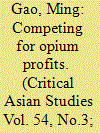

|
|
|
|
|
| Summary/Abstract |
This paper highlights the lives of Japanese and Korean subjects of Imperial Japan who were involved in opium production and circulation in Manchukuo. It discusses the dynamics, practices, and experiences of opium production and circulation. This paper provides a new reading of the diverse beneficiaries on the ground and of the opium industry in Manchukuo from the angles of production and circulation. Even as authorities continued to make significant revenue from the opium trade, the opium industry provided opportunities for diverse actors to profit from taking part in the state opium monopoly scheme. The interplay of these actors eroded Japanese imperial control over the new state. By dissecting the entanglement of the complex nature of the opium industry within a regional context, the paper demonstrates how the state actors were compelled to take action to combat illegal opium growing and selling.
|
|
|
|
|
|
|
|
|
|
|
|
|
|
|
|
| 2 |
ID:
188578
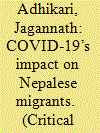

|
|
|
|
|
| Summary/Abstract |
This article examines how COVID-19 has impacted Nepalese migrants’ vulnerability and the actions they have taken to adapt to the situation. It investigates the problems created by COVID-19 from a disaster-risk management approach, the preparatory measures taken to deal with the disaster, and efforts by state and non-state actors in migrants’ rescue, relief, and reintegration into society. Marginal migrants, including unskilled workers, women, undocumented individuals, have been most affected by the pandemic, something which was also overlooked by government policies. The study shows that because government subsidies for migrants were too meagre and came too late, migrants have started going back abroad, despite COVID-19 risks. Furthermore, the study reveals that Nepalese migrants’ vulnerability depends on their levels of education, skills, gender, and legal status. In the light of these findings, the Nepal government needs a stronger institutional structure to help migrants navigate transnational spaces.
|
|
|
|
|
|
|
|
|
|
|
|
|
|
|
|
| 3 |
ID:
188574


|
|
|
|
|
| Summary/Abstract |
Following a particularly violent police operation inside the Prince Edward subway station on August 31 2019, during the anti-extradition movement in Hong Kong, a group of older women performed mourning rituals for the possibly dead outside the subway exit for almost one hundred days. In view of increasing police surveillance, violence, and arrests, these women’s religious practices and the sociality they generated constituted a form of infrapolitics. By carefully performing their gendered roles as funerary experts, these women created a makeshift shrine that operated symbolically as a public sphere of dissent. This paper examines the making of their shrine in the context of widespread public discontent about police brutality, and by extension, state violence in a broader political-economic context. Without knowing who was being memorialized, the continuous flow of mourners to the Prince Edward Station shrine compels scholars to consider what these possible deaths could mean and what other losses they were accounting for. Through the lens of infrapolitics, these women’s creative appropriation of mourning rituals directs our attention to the amebic vitality of resistance and its persistence against great odds.
|
|
|
|
|
|
|
|
|
|
|
|
|
|
|
|
| 4 |
ID:
188575
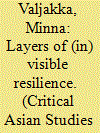

|
|
|
|
|
| Summary/Abstract |
Building on a critical gendered approach at the intersection of arts, women, and homelessness, this article calls attention to the structured layers of (in)visibilities of female agency, existence, and resilience. The arts have a special place and importance in civil society formation in relation to homelessness in Japanese cities today, so the aim is to elucidate the significant but understudied role of women in enhancing varied forms of resilience in the urban environment. Arts, activism, and, in particular, art activism on socio-political issues in Asian cities are typically perceived as methods of resistance against local and national governments, whereas their crucial contribution to urban resilience often remains unrecognized. By investigating the emergent forms of interdisciplinary arts in Tokyo and Osaka that are aimed at sustainability in less-privileged living conditions, this article contributes to the growing field of studies acknowledging how these circumstances are brought about not only by economic ruptures but also by gendered socio-structural and cultural factors. By recognizing the intricate parameters of the varied artistic practices, a more nuanced understanding of the gendered urban resilience in maintaining communities, neighborhoods, and cities can be gained.
|
|
|
|
|
|
|
|
|
|
|
|
|
|
|
|
| 5 |
ID:
188576


|
|
|
|
|
| Summary/Abstract |
Studies of Indigeneity in Southeast Asia have consistently stressed its contested nature. The relevance of the concept has been questioned by governments in this region on the basis that both majority and minority ethnic groups are equally Indigenous. An interesting divergence from this is Cambodia where the term “Indigenous” is recognized in Cambodian law. This has largely been permitted because the term in Khmer is applicable to both ethnic minorities and the Khmer majority. This raises the question of how the concept of Indigenous is interpreted and used in Khmer and other languages. This article explores the root meaning of the Khmer term. Understanding how the concept of Indigeneity has itself been indigenized opens possibilities for building nuances of the term which can provide constructive approaches to addressing majority/minority cultural dynamics. In other words, exploring how terms developed from other contexts have been transposed into local languages can allow for contextualizing concepts to address local realities. A wider understanding of the concept of Indigenous in Khmer allows for building on the concept of Indigeneity in Cambodia, and perhaps other Southeast Asian contexts.
|
|
|
|
|
|
|
|
|
|
|
|
|
|
|
|
| 6 |
ID:
188573
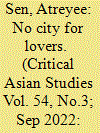

|
|
|
|
|
| Summary/Abstract |
This article explores the quotidian politics of women’s virtue vigilante groups in Mumbai. It illustrates the multiple ways in which lower class “respectable women,” ranging from members of ladies’ groups to lone-wolf leaders, actively participate in cleansing the cityscape of what they believe is “sexual vulgarity” by daily surveillance over public displays of love in poor and peripheral localities. This militant scrutiny of urban public conduct is intimately related to daily security anxieties about those they label as perverts, sex addicts, and pedophiles occupying urban areas, which are still safe spaces for less affluent women and children. These women’s groups and their resilient/adaptable moral authority in the management of public space offer imperceptible and enduring challenges to the hegemony of police governance over such urban spatial orders.
|
|
|
|
|
|
|
|
|
|
|
|
|
|
|
|
| 7 |
ID:
188579
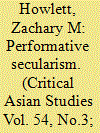

|
|
|
|
|
| Summary/Abstract |
This article examines the role of religion in China’s National College Entrance Exam, the Gaokao. In Chinese schools, religion is officially banned and branded superstition. But some Gaokao-preparatory high schools sponsor pilgrimages to pray for exam success, invite ritualists to exorcize ghosts, and tolerate discussions of karmic merit, euphemistically termed “character” (renpin). Based on two years of ethnographic fieldwork in rural and urban schools in Fujian Province, this article argues that such practices help people maintain self-efficacy while revealing secularism to be a performance. Hypercompetition in the post-Mao era (1977–present) has created a perceived disconnect between effort and reward, and to restore that balance, people appeal to local gods and cosmic reciprocity. But elites must pay deference to secular ideals while quietly pursuing local practices in what sociologist Erving Goffman terms the backstage. Such Janus-faced obeisance has analogs in the imperial era. By analyzing secularism as a performance with early modern genealogies, this article advances understanding of Chinese regime legitimacy, adds to ethnographies of secularism’s lived experience in Asia, and helps to account for why popular religion continues to flourish despite more than a century of suppression.
|
|
|
|
|
|
|
|
|
|
|
|
|
|
|
|
| 8 |
ID:
188577
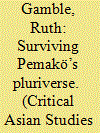

|
|
|
|
|
| Summary/Abstract |
This article traces a multi-generation history of Kunga Tsomo’s family, from the early 1900s when her grandmother migrated to Pemakö in the eastern Himalaya until the twenty-first century. Grandmother’s journey to Pemakö was part of a larger Vajrayana Buddhist migration to “hidden lands” in the southern Himalaya. This movement is most often framed as a religious event, but also involved the dispossession of Indigenous peoples, including the Adi of southern Pemakö. After coming to a negotiated settlement over land, the newly arrived Vajrayana Buddhists and Adi lived in neighboring villages within different ontologies. But soon after this settlement, a series of external states and institutions colonized Pemakö. The British and Qing Empires sent military expeditions in the 1910s. In the 1930s, the Tibetans annexed the territory. In the 1950s, it was bifurcated by the Sino-Indian border dispute. In the twenty-first century, it has become a site of a contest between international conservation campaigns and Chinese and Indian hydropower extraction. Despite the transformative effects of these external powers, this is not a story of cultural erasure. The article shows how the family’s commitment to Pemakö, its land and its multiple cultures has helped them survive and thrive.
|
|
|
|
|
|
|
|
|
|
|
|
|
|
|
|
|
|
|
|
|